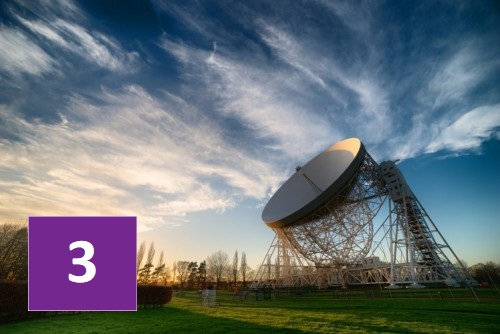2019's top news from the Faculty of Science and Engineering
2019 produced many big news stories in The University of Manchester's Faculty of Science and Engineering. Here, we run down the top ten most popular newsroom posts of the year in reverse order.
Astronomers discover ghosts of supernovas in nearby galaxy
Researchers from The University of Manchester, with international colleagues, carried out a unique survey of a nearby galaxy.
Dr Tana Joseph, from the Department of Physics and Astronomy, contributed to a survey of the nearby Small Magellanic Cloud (SMC), a nearby dwarf galaxy. Dr Joseph is the first author of the resultant paper, published in the journal Monthly Notices of the Royal Astronomical Society.
The researchers discovered two potential new supernova remnants – the cloud of gas and dust left over after a star explodes. In addition, they detected radio signals from more than 20 planetary nebulae which were already known from optical observations.
The graphene sieve returns
Despite being a story from back in 2017, the graphene sieve which was shown to be able to turn sea water into drinking water was still one f the most-read stories for 2019. Graphene-oxide membranes have attracted considerable attention as promising candidates for new filtration technologies. Now the much sought-after development of making membranes capable of sieving common salts has been achieved.
New research demonstrates the real-world potential of providing clean drinking water for millions of people who struggle to access adequate clean water sources.
First scalable graphene yarns for wearable textiles produced
Graphene strikes again as a team of researchers led by Dr Nazmul Karim and Prof Sir Kostya Novoselov at The University of Manchester developed a method to produce scalable graphene-based yarn.
Multi-functional wearable e-textiles have been a focus of much attention due to their great potential for healthcare, sportswear, fitness and aerospace applications.
Graphene has been considered a potentially good material for these types of applications due to its high conductivity, and flexibility. Every atom in graphene is exposed to its environment allowing it to sense changes in its surroundings, making it an ideal material for sensors.
Unearthing the secrets of the American ‘Jurassic Mile’
Scientists at The University of Manchester have joined forces with a major US Museum and European partners to explore an extraordinary Jurassic dinosaur site in the badlands of Wyoming, USA.
Scientists from The University of Manchester are the academic leaders on the $27.5 million (£20m) project to explore, research and eventually exhibit fossils from a recently discovered palaeontological site known as the ‘Jurassic Mile’.
“It is splendid that such an important site has been discovered at just the right time, as the science of paleontology is adapting existing and new imaging techniques to unpick the fossil remains of extinct life.” said Professor Phil Manning, “The imaging work that we undertake at Manchester is already world-leading and this is a great opportunity to develop this research with other world-class institutions.”
Alan Turing is face of new £50 note
In July it was announced that Alan Turing would be the next face on the £50 note, as revealed by the Bank of England Governor, Mark Carney.
Making the announcement at the Science and Industry Museum in Manchester, the Governor also revealed the imagery depicting Alan Turing and his work that will be used for the reverse of the note.
The eminent mathematician and computer scientist, who is often dubbed ‘the father of modern computing’, was based at The University of Manchester after World War II. During the war he famously worked with the British Intelligence Service at Bletchley Park to help break the German Enigma machine.
Massive Attack partner with University of Manchester to explore music industry climate impact
Bristol-based band Massive Attack are partnering with climate scientists at The University of Manchester’s Tyndall Centre to jointly examine the key impact areas of the music industry on the environment.
The scientists and band will collaborate on a new project to obtain and analyse data from the Massive Attack touring schedule with an aim to providing information and guidance to the wider music industry to reduce negative environmental impact in the midst of the increasing climate emergency.
Three million year old fossilised mouse reveals evolutionary secrets of colour
The evolutionary use of colour for mammal’s survival in the wild is evident from, red foxes, to zebras. Today an international team, led by researchers from The University of Manchester, publish research revealing the evidence of colourful pigments from ancient mouse remains.
Colour plays an important role in the evolution of life on Earth, it has also played a role in the selective processes that have steered evolution for hundreds of millions of years.
The paper, ‘Pheomelanin pigment remnants mapped in fossils of an extinct mammal’ is published in the journal Nature Communications. The work marks a major scientific breakthrough in our ability to define fossilised colour pigments in long extinct species for the first time.
Jodrell Bank added to UNESCO World Heritage List
Jodrell Bank Observatory in Cheshire was added to the UNESCO World Heritage List in July.
The observatory becomes the 32nd UNESCO World Heritage Site in the UK and joins the prestigious list alongside international sites such as Machu Picchu, the Great Wall of China and the Taj Mahal.
Jodrell Bank, owned by The University of Manchester, is famous as the home of the Lovell Telescope, the world’s third largest steerable radio telescope. Completed in 1957, the dish was the largest of its kind anywhere in the world until 1973 and was the catalyst for the construction of many other large scale satellite dishes.
ID Manchester sets out bold ambition to be the innovation capital of Europe
Back in March The University of Manchester presented a unique opportunity to become its partner in delivering a new, world-class innovation district in the heart of Manchester, the £1.5 billion ID Manchester.
The presentation, which took place at the Manchester Pavilion at MIPIM, was attended by over 150 property professionals from all over the world, revealed The University of Manchester expects its joint partner to match its bold ambition to create a new neighbourhood which will nurture the next generation of game-changing businesses and bring huge economic benefits to Manchester.
Now an international team of researchers have resolved a key fundamental issue of material defect which limits and degrades solar cell efficiency. The problem has been known about and studied for over 40 years, with over 270 research papers attributed to the issue with no solution.
Solar cell defect mystery solved after decades of global effort
Finally, the most popular science and engineering story of the year saw a team of scientists at The University of Manchester solve a key flaw in solar panels after 40 years of research around the world.
Solar panels are among the most available system of generating energy through renewable sources due to their relative cost and consumer availability. However, the majority of solar cells only achieve 20% efficiency – for every kW of equivalent sunlight, about 200W of electrical power can be generated.
Now an international team of researchers have resolved a key fundamental issue of material defect which limits and degrades solar cell efficiency. The problem has been known about and studied for over 40 years, with over 270 research papers attributed to the issue with no solution.










